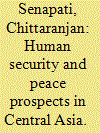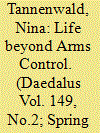| Srl | Item |
| 1 |
ID:
129066


|
|
|
|
|
| Publication |
2014.
|
| Summary/Abstract |
Central Asia has always been a blend of cultures due to its massive migrations and the mixing of peoples coming from outside. In this context this mixture of people in many ways reflected both the best and the worst that each group had to offer. ln the "Great Game" of the Nineteenth century influ-ences from the North and the South played a part in shaping the region'. This unique blend of peoples and cultures are not seen elsewhere in the world (Table 1). To manage this blend of people will always be difficult. So most of the time this bland poses the issues of conflict and insecurity. Be that it is, human security can be an approach to provide security to Central Asian countries. However, in early 1990s, the fall of Berlin Wall (1989), demise of the soviet communism and ascendancy of the neoliberal global regime, altered the international power structure from bipolar to multi-polar world order and this has resulted into the emergence of new security concerns like global terrorism, environmental issues, energy security, food security etc. In the new complicated situation the Central Asian Republics (CARS) have been goaded to rethink the very notion of security from different perspectives.
|
|
|
|
|
|
|
|
|
|
|
|
|
|
|
|
| 2 |
ID:
172903


|
|
|
|
|
| Summary/Abstract |
Today, we are on the verge of a world without nuclear restraint. In the absence of formal arms control, how do we proceed? What broad principles and norms would we want? What measures might nuclear-armed states take, even without formal agreement, that would reduce the risk of nuclear war and control the arms race? I suggest that nuclear-armed states move toward a global regime of nuclear restraint and responsibility. Restraint would primarily take the form of reciprocal commitments and unilateral measures to avoid an arms race and reduce nuclear dangers. Responsibility refers to the fact that nuclear-armed states must pursue limited forms of deterrence and are accountable to the international community. I suggest several steps that governments, with the help of civil society, could take, beginning with the most minimal, declaratory initiatives and unilateral measures, and proceeding to steps that require more action.
|
|
|
|
|
|
|
|
|
|
|
|
|
|
|
|